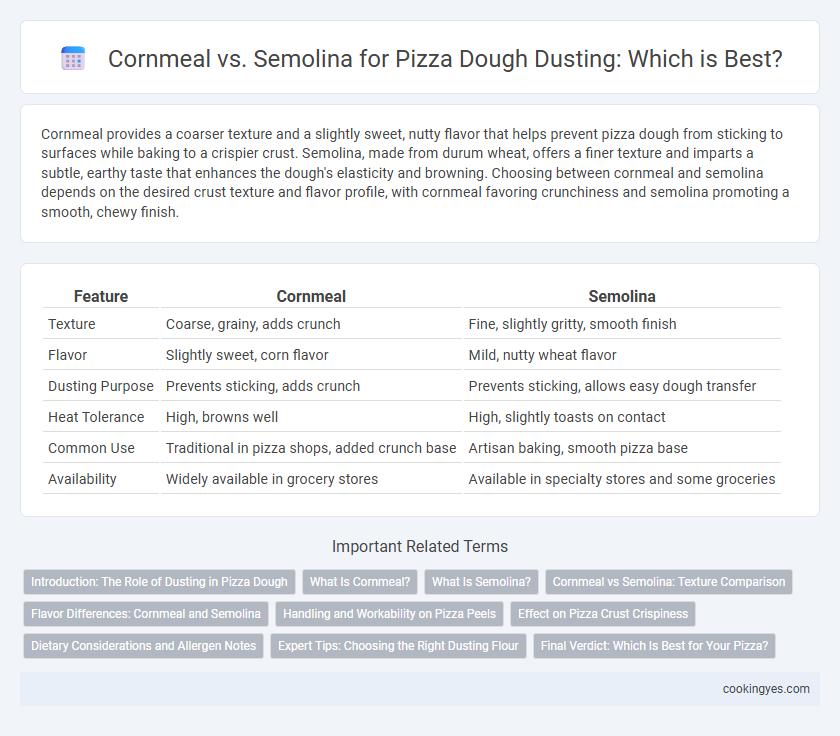Cornmeal provides a coarser texture and a slightly sweet, nutty flavor that helps prevent pizza dough from sticking to surfaces while baking to a crispier crust. Semolina, made from durum wheat, offers a finer texture and imparts a subtle, earthy taste that enhances the dough's elasticity and browning. Choosing between cornmeal and semolina depends on the desired crust texture and flavor profile, with cornmeal favoring crunchiness and semolina promoting a smooth, chewy finish.
Table of Comparison
| Feature | Cornmeal | Semolina |
|---|---|---|
| Texture | Coarse, grainy, adds crunch | Fine, slightly gritty, smooth finish |
| Flavor | Slightly sweet, corn flavor | Mild, nutty wheat flavor |
| Dusting Purpose | Prevents sticking, adds crunch | Prevents sticking, allows easy dough transfer |
| Heat Tolerance | High, browns well | High, slightly toasts on contact |
| Common Use | Traditional in pizza shops, added crunch base | Artisan baking, smooth pizza base |
| Availability | Widely available in grocery stores | Available in specialty stores and some groceries |
Introduction: The Role of Dusting in Pizza Dough
Dusting pizza dough with cornmeal or semolina prevents sticking and adds texture during baking. Cornmeal offers a coarse grain that creates a crunchy, toasted crust, while semolina provides a finer, slightly gritty feel enhancing dough handling and oven spring. Choosing the right dusting flour influences the pizza's crust texture and overall baking performance.
What Is Cornmeal?
Cornmeal is a coarse flour ground from dried corn kernels, commonly used to dust pizza dough to prevent sticking while baking. Its granular texture creates a crispy, slightly crunchy crust bottom, adding a distinct flavor that complements the dough. Compared to semolina, cornmeal is less dense and imparts a milder corn taste, enhancing the overall pizza eating experience.
What Is Semolina?
Semolina is a coarse, purified wheat middling of durum wheat primarily used in pasta and pizza dough dusting due to its high protein content and granular texture. Its coarser grains provide a non-stick surface that prevents dough from sticking to surfaces while baking, ensuring a crisp, well-textured crust. Compared to cornmeal, semolina offers a more subtle crunch and a slightly nutty flavor, making it ideal for fine-tuning the texture and taste of pizza crusts.
Cornmeal vs Semolina: Texture Comparison
Cornmeal creates a coarser texture for pizza dough dusting, offering a slightly crunchy bite and preventing sticking on pans or ovens. Semolina provides a finer, grainier texture that enhances the dough's crispiness without overwhelming the crust's surface. Choosing between cornmeal and semolina depends on the desired crunch and texture balance in the final pizza crust.
Flavor Differences: Cornmeal and Semolina
Cornmeal dusting imparts a slightly sweet, nutty flavor with a coarse texture that crisps well on pizza crust edges. Semolina offers a more subtle, wheaty taste and a finer grain, contributing to a delicate crunch and improved dough handling. Choosing between cornmeal and semolina affects the pizza's overall flavor profile and crust texture, enhancing authenticity and mouthfeel.
Handling and Workability on Pizza Peels
Cornmeal provides a coarse texture that minimizes dough sticking to pizza peels, enhancing handling and ease of sliding raw dough onto hot surfaces. Semolina's slightly finer grind offers excellent workability, allowing for smooth dough movement while absorbing excess moisture. Choosing between cornmeal and semolina depends on desired dough release and texture preferences during the pizza-making process.
Effect on Pizza Crust Crispiness
Cornmeal creates a coarse barrier between the dough and the pizza peel, absorbing moisture and enhancing crust crispiness by preventing sogginess during baking. Semolina flour, with its finer texture and high protein content, contributes to a slightly crunchier crust while allowing easier sliding of the dough onto the oven surface. Choosing between cornmeal and semolina for dough dusting directly impacts the texture and crispiness of the pizza crust, influencing the final bite quality.
Dietary Considerations and Allergen Notes
Cornmeal, gluten-free and high in fiber, suits those with gluten intolerance or celiac disease, providing a coarse texture that prevents dough from sticking. Semolina, made from durum wheat, contains gluten and offers a slightly nutty flavor with a finer grind, ideal for those without wheat allergies seeking traditional pizza crust characteristics. Choosing between cornmeal and semolina depends on dietary restrictions, with cornmeal preferred for allergen-free options and semolina favored for enhanced dough handling and taste.
Expert Tips: Choosing the Right Dusting Flour
Cornmeal offers a coarse texture that prevents pizza dough from sticking while adding a subtle crunch, favored by Neapolitan-style pizza makers for its rustic finish. Semolina flour provides a finer, slightly gritty surface that allows easy dough handling with less burn risk in high-heat ovens, preferred by artisan pizza chefs seeking a delicate crust. Experts recommend testing both dusting flours to match your oven temperature and desired crust texture, optimizing pizza quality through precise flour selection.
Final Verdict: Which Is Best for Your Pizza?
Cornmeal offers a gritty texture that prevents dough from sticking and adds a subtle crunch to pizza crusts, making it ideal for those who prefer a rustic bite. Semolina, with its finer grain and higher protein content, creates a smoother surface and enhances the dough's elasticity, resulting in a crispier, more evenly baked crust. Choosing between cornmeal and semolina depends on your desired texture: go for cornmeal for a crunchy, textured base or semolina for a clean, crisp finish that complements classic Neapolitan-style pizzas.
Cornmeal vs Semolina for dough dusting Infographic

 cookingyes.com
cookingyes.com